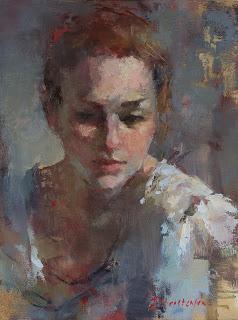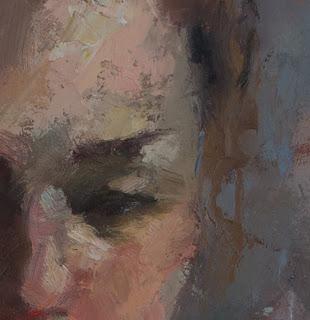
Sidelong Gaze
16 x 12

detail
I used to be a watercolourist when I started painting, but I soon switched to oils. The reason? Texture! There's something wonderful about the way that oil paint can move beyond 2 dimensions and enter the 3rd. Ingres' smooth, enamel-like surfaces are impressive, but give me Monet's crusty canvases, Sargent's thick, dashing swirls of paint, or Freud's heavily layered surfaces any day. They hold my attention for the rugged physicality of the paint itself; there is both an exciting image, and exciting paint application.
This painting takes texture pretty far as I used a knife heavily throughout. There was plenty of brush action, as well, but the knife was what saved the piece from being boring to me. It's painted on a gessoed panel which is a surface that I'm not sold on. It doesn't grab paint in the way that linen does, and I find the brush marks that I make on it look uninteresting to me. The best way to explain it is that when I make those first few marks, I can already see exactly where the painting will end up when it's finished; the repertoire of possible brush marks - at least alla prima marks - is limited, and there's nothing more tedious. A painting should be full of surprises and discoveries, especially for the painter, or else it seems like a pointless exercise to me. This belief explains why I discard a lot of work as too boring to see the light of day, and also why I eagerly walk into the studio each day: I'm looking for the next great surprise.
So, to counteract the surface, I did a lot of knife work for the relatively uncontrolled element that it adds to the painting. The best painting knives are long and very flexible; my favorite one is about 2" long and triangular. Inflexible ones are good for scraping paint, or for mixing it on the palette, and the teeny, tiny, diamond-shaped ones have no purpose that I can discern. A good painting knife will lay down a hefty amount of paint with surprising precision, but it won't let you get too finicky. It also allows you to place very clean paint over wet paint, creating a sense of depth. You can see that in the detail of the forehead above. Under that clean pink layer, there's some murky, cool, greenish paint. A brush couldn't have kept them separate in the same way.
I advise my students to keep their palette knives perfectly smooth and clean -rubbing it on sandpaper can often bring a knife back to full use - and discourage cheap, plastic knives; they're not capable of subtle paint application. Like scrapers, rollers, squeegies, and other tools, knives are a way to break monotony for both the painting and the painter.
Happy painting!

